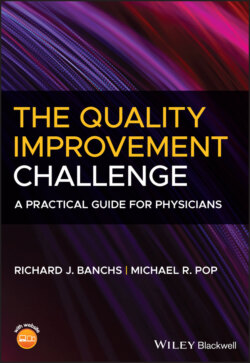Читать книгу The Quality Improvement Challenge - Richard J. Banchs - Страница 23
GUIDING PRINCIPLES
ОглавлениеThese five guiding principles are the values that establish our framework for all improvement efforts in the healthcare environment:
1 Problems need to be approached using the lens of the customer. To understand a problem, we need to see the problem from the lens of the people who experience them; we need to “walk” in their shoes, understand their issues, and be willing to address their needs. Improvement is only realized when we place the end user’s needs and experiences at the heart of the process. Value is created by focusing the efforts of staff and providers on the needs and expectations of the patient or the end user. End users are the experts of their own experience, and are central to the process of creating a solution that delivers on their expectations.
2 Consider the people who deliver care as the key to the solution. The people who deliver care and experience the problems of the system are the key; we need to bring them along in the improvement process because they are the ones who understand the system and hold the key to the solution. Healthcare professionals see and understand the challenges our patients face. Their understanding of the process and proximity to the patients makes them uniquely suited to identify and deliver potential solutions that can improve the healthcare experience. To improve, we must engage providers and staff. They have a pivotal role and are the linchpin that makes possible the success of the improvement efforts. Front line stakeholders have valuable insights into their processes and the barriers they face in delivering high‐quality patient care, but they often have minimal opportunity to share that proficiency in modifying their workflows. In most organizations, there is an enormous reservoir of “energy, ideas, and engagement that is never tapped into because of management practices that reduce intrinsic motivation and hinder joy and creativity in work” (Rena Awdish 2018).
3 Be willing to try, fail, and try again. Improvement in healthcare is complicated. Improvement is an imperfect process that requires our willingness to design and test solutions, and when they fail, to learn from our mistakes. In a risk‐averse culture such as healthcare, improvement is difficult. We just need to make sure that our failures do not harm our patients. Engaging in the right kind of testing produces the right kind of failures from which we can learn. Quotable quote: “Fall seven times. Stand up eight.” Japanese proverb
4 To improve, sometimes we must think “out of the box.” The traditional formula of continuous incremental improvements sometimes delivers disappointing results when it comes to the operational side of healthcare. We may not achieve the dramatic results we expected, largely because we may have been trying to improve the “old way” of doing things. Sometimes we have to stop focusing on improving what appears to be outdated models that were successful in the past but have outlasted the circumstances that created the need for them. For these processes, improvements cannot address what is fundamentally wrong with them. They have underlying deficiencies in their conceptualization, structure, job design, workflows, and control mechanisms because they were designed to address the needs of a different time. Improvement cannot succeed when it relies on an obsolete paradigm. When this is the case, we must redesign our processes using our knowledge, and a clear understanding of the needs of our patients.
5 Consider all improvement a change. All improvement is a change, and change is always met with varying degrees of resistance. For change to occur, QI teams must create a space where growth can develop, giving the frontline professionals the opportunity to understand the problem, discuss barriers to success, and engage in the co‐creation and implementation of solutions. The effectiveness of our improvement effort results not only from the quality of the solution but also from the engagement and buy‐in of the frontline professionals. If staff and providers do not accept the change, it is very unlikely that improvement will succeed. We must understand what drives change at the front line, and then design strategies to overcome the natural resistance that so often derails our improvements efforts. Change cannot succeed without the commitment of the people that it will affect.
